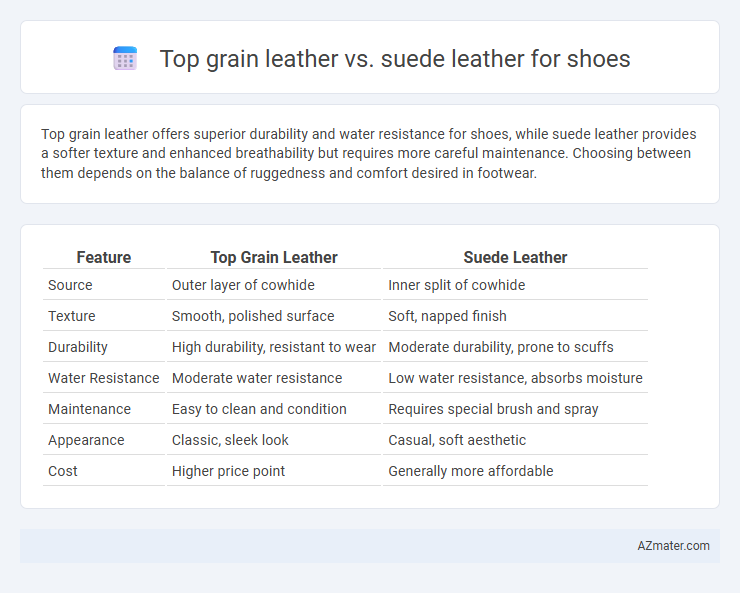Top grain leather offers superior durability and water resistance for shoes, while suede leather provides a softer texture and enhanced breathability but requires more careful maintenance. Choosing between them depends on the balance of ruggedness and comfort desired in footwear.
Table of Comparison
| Feature | Top Grain Leather | Suede Leather |
|---|---|---|
| Source | Outer layer of cowhide | Inner split of cowhide |
| Texture | Smooth, polished surface | Soft, napped finish |
| Durability | High durability, resistant to wear | Moderate durability, prone to scuffs |
| Water Resistance | Moderate water resistance | Low water resistance, absorbs moisture |
| Maintenance | Easy to clean and condition | Requires special brush and spray |
| Appearance | Classic, sleek look | Casual, soft aesthetic |
| Cost | Higher price point | Generally more affordable |
Introduction to Top Grain Leather and Suede Leather
Top grain leather, derived from the outermost layer of the hide, offers durability, smooth texture, and resistance to moisture, making it ideal for high-quality shoes. Suede leather, created from the underside of the hide, features a soft, napped finish that provides a supple feel but requires more care due to its vulnerability to stains and water damage. Both materials cater to distinct styles and functions, with top grain leather excelling in longevity and suede offering a luxurious aesthetic.
What is Top Grain Leather?
Top grain leather is the second-highest quality leather made from the outer layer of a hide, known for its durability and smooth surface after being sanded and refinished. It offers a balance between strength and aesthetic appeal, making it ideal for shoes requiring longevity and a polished look. Unlike suede, which is made from the underside of the hide and has a soft, napped finish, top grain leather provides better water resistance and easier maintenance.
What is Suede Leather?
Suede leather is made from the underside of animal hides, primarily lamb, goat, or calf, featuring a soft, napped finish that distinguishes it from smooth top grain leather. This type of leather offers a velvety texture that is more flexible but less durable and water-resistant compared to top grain leather, making suede ideal for stylish, casual shoes rather than heavy-duty use. Suede's porous surface requires specialized care to maintain its appearance and protect against stains and moisture damage.
Manufacturing Process Comparison
Top grain leather undergoes a process where the outermost layer is sanded and buffed to eliminate imperfections, retaining durability and a smooth finish ideal for shoes. Suede leather is created by splitting the inner layer of the hide and buffing it to produce a napped, soft texture with a more delicate and porous surface. Manufacturing top grain leather involves higher heat and pressure treatments for toughness, while suede requires careful handling to preserve its fibrous nap and softness during production.
Appearance and Texture Differences
Top grain leather for shoes features a smooth, polished surface with a subtle natural grain, offering a sleek and refined appearance ideal for formal wear. Suede leather displays a soft, napped texture with a matte finish, characterized by its fuzzy feel that provides a casual and relaxed aesthetic. The durability of top grain leather surpasses suede, which is more prone to stains and abrasions due to its open fiber structure.
Durability and Longevity
Top grain leather offers superior durability and longevity compared to suede leather due to its dense fiber structure and resistance to abrasion, making it ideal for long-lasting shoe use. Suede leather, while softer and more flexible, is more prone to scuffing, staining, and wear, which reduces its overall lifespan in footwear. Investing in top grain leather shoes ensures a more resilient and weather-resistant option for extended daily wear.
Comfort and Breathability
Top grain leather offers superior durability and moderate breathability, making it comfortable for extended wear as it conforms to the foot over time. Suede leather, known for its soft and supple texture, provides enhanced breathability due to its open fiber structure, promoting better airflow and moisture regulation. However, suede typically requires more maintenance and may lack the long-term support that top grain leather delivers in shoe construction.
Maintenance and Care Requirements
Top grain leather shoes demand regular cleaning with a damp cloth and periodic conditioning to maintain suppleness and prevent cracking, while avoiding excessive moisture exposure. Suede leather shoes require gentle brushing with a suede brush to remove dirt and restore texture, alongside protective sprays to guard against water and stains, as their porous surface is more prone to damage. Both materials benefit from proper storage in a cool, dry place to extend the lifespan of the footwear.
Suitability for Various Shoe Styles
Top grain leather offers superior durability and a polished finish, making it ideal for formal and dress shoes such as oxfords, brogues, and loafers. Suede leather provides a softer texture and casual appearance, best suited for moccasins, desert boots, and casual sneakers, where comfort and style flexibility are prioritized. Both materials serve distinct shoe styles based on their texture, maintenance needs, and overall aesthetic.
Price and Value Comparison
Top grain leather shoes typically cost more than suede leather due to their durability, resistance to stains, and smoother finish that enhances longevity. Suede shoes, while generally more affordable, offer a softer texture and aesthetic appeal but require more maintenance and are prone to staining and wear. The value balance depends on usage; top grain leather provides long-term investment for durability, whereas suede suits casual wearers prioritizing style over ruggedness.

Infographic: Top grain leather vs Suede leather for Shoe
 azmater.com
azmater.com